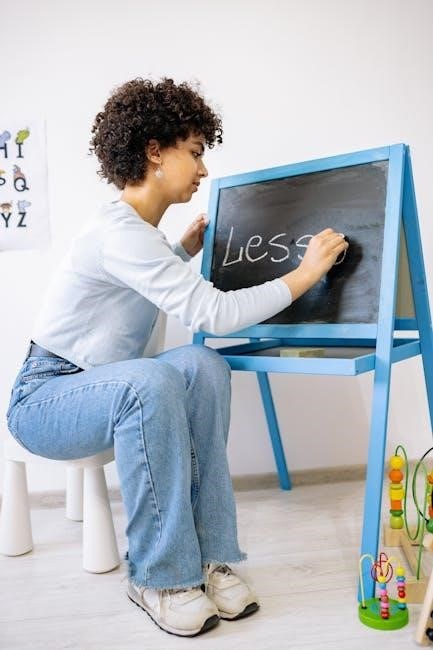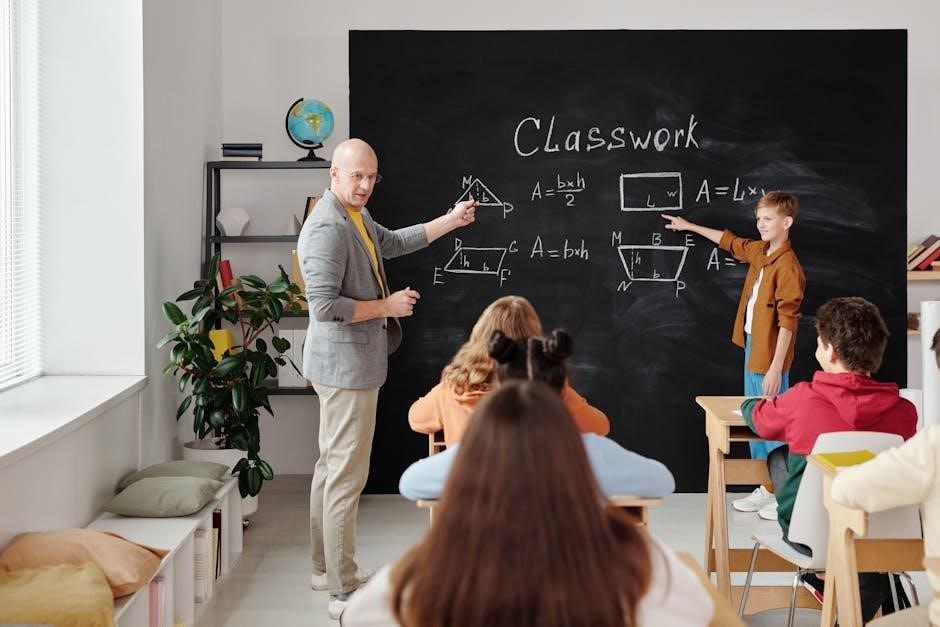The first instruction a teacher gives sets the tone for the class, establishing expectations and engagement while fostering a positive learning environment․

The Importance of the First Instruction
The first instruction is crucial as it sets expectations, establishes routines, and influences student engagement and respect, shaping the classroom environment effectively․
1․1․ Setting the Tone for the Class
The first instruction a teacher gives plays a pivotal role in setting the tone for the entire class․ It establishes the teacher’s expectations, classroom culture, and the level of engagement expected from students․ A well-structured first instruction demonstrates professionalism and preparedness, immediately conveying the importance of respect and focus․ This initial interaction helps students understand the norms and behaviors that will guide their learning experience․ By starting with clarity and confidence, the teacher creates an environment where students feel safe, motivated, and ready to learn․ A strong opening also encourages active participation and sets the foundation for building trust and rapport throughout the academic journey․
When the first instruction is delivered effectively, it fosters a positive and inclusive atmosphere, making students more receptive to the lesson ahead․
1․2․ Establishing Teacher-Student Relationship
The first instruction a teacher gives lays the groundwork for the teacher-student relationship, fostering mutual respect and trust․ A clear and respectful tone encourages students to feel comfortable and valued, creating an environment where communication thrives․ By addressing students thoughtfully and setting expectations, the teacher demonstrates empathy and understanding, which are crucial for building rapport․ This initial interaction also highlights the teacher’s commitment to student success, encouraging students to engage actively and feel supported․ A positive start helps students view the teacher as a guide and mentor, strengthening their willingness to participate and learn․ This relationship-building process begins with the first instruction, setting a foundation for collaboration and growth throughout the year․

1․3․ Creating a Positive Learning Environment
A teacher’s first instruction plays a pivotal role in shaping the classroom atmosphere, fostering a positive and inclusive learning environment․ By setting clear expectations and encouraging active participation, the teacher promotes mutual respect among students․ This initial interaction helps students feel safe and valued, which is essential for their emotional and academic growth․ A well-structured first instruction also highlights the importance of collaboration and shared responsibility, creating a sense of community․ When students perceive the classroom as a supportive space, they are more likely to engage enthusiastically and take risks in their learning journey․ This foundation of positivity and respect enables students to thrive academically and socially, making the learning environment conducive to their overall development․
1․4․ The Impact on Student Engagement
The first instruction significantly influences student engagement by setting the tone for active participation․ Clear and structured guidance helps students understand expectations, fostering a sense of purpose․ When the initial instruction is engaging, it captures students’ attention, encouraging them to contribute enthusiastically․ Effective first instructions often include interactive elements, such as questions or hands-on activities, which motivate students to take an active role in learning․ Additionally, a well-delivered first instruction establishes a routine, making students feel secure and focused․ This, in turn, enhances their willingness to engage with the material and collaborate with peers․ By prioritizing engagement from the start, teachers create a dynamic and inclusive classroom environment that promotes meaningful learning experiences for all students․

Classroom Management Strategies
Effective classroom management strategies involve establishing clear expectations, promoting active listening, encouraging student participation, and managing behavior to create a structured and productive learning environment․
2․1․ Establishing Expectations and Rules
Establishing clear expectations and rules is crucial for creating a structured and respectful classroom environment․ From the start, teachers should communicate these guidelines to ensure students understand what is expected of them․ This helps build accountability and responsibility, fostering a culture of mutual respect․ By setting specific, measurable, and achievable standards, teachers can promote a positive atmosphere where learning thrives․ Consistency in enforcing these rules is key to maintaining order and ensuring fairness․ When students know the boundaries and consequences, they are more likely to engage productively and focus on their academic goals․ Clear expectations also help minimize disruptions, allowing teachers to dedicate more time to instruction and student support․
2․2․ Promoting Active Listening

Promoting active listening is essential for fostering engagement and understanding in the classroom․ Teachers can achieve this by encouraging students to focus on the speaker, process information, and respond thoughtfully․ Techniques like “cold calling” or structured discussions help create a habit of attentive listening․ Additionally, strategies such as “turn and talk” or “think-pair-share” allow students to engage with content deeply․ Teachers should model active listening themselves, demonstrating eye contact, nodding, and paraphrasing․ Providing clear instructions and minimizing distractions also support this practice․ By fostering an environment where listening is valued, teachers help students develop critical thinking and communication skills, ensuring they are fully present and engaged in lessons․
2․3․ Encouraging Student Participation
Encouraging student participation is vital for creating an interactive and inclusive classroom environment․ Teachers can foster participation by asking open-ended questions, using think-pair-share activities, and incorporating group discussions․ Structured routines like “cold calling” ensure all students are engaged, while formative assessments help gauge understanding․ Providing scaffolding tools and clear instructions enables students to contribute confidently․ Positive reinforcement, such as acknowledging contributions, builds a supportive atmosphere․ Encouraging questions and allowing time for reflection also promote deeper engagement․ By creating opportunities for every student to voice their thoughts, teachers cultivate a sense of ownership and responsibility, leading to increased motivation and active learning․
2․4․ Managing Classroom Behavior
Managing classroom behavior begins with establishing clear expectations and routines․ The first instruction sets the tone, ensuring students understand the importance of respect and focus․ Consistent enforcement of rules, such as raising hands to speak, helps maintain order․ Positive reinforcement, like acknowledging good behavior, encourages adherence to guidelines․ Non-verbal cues, such as gestures, can subtly redirect students without disrupting the flow․ Teachers should address misbehavior calmly and privately to avoid embarrassing students․ Encouraging self-regulation and responsibility fosters a respectful environment․ By creating a structured yet supportive setting, teachers can minimize disruptions and promote a focused, productive classroom atmosphere․ Effective behavior management ensures all students can learn and thrive․

Lesson Planning and Preparation
Effective lesson planning involves defining clear objectives, structuring activities, and aligning with curriculum standards to ensure engaging and purposeful instruction from the first teacher’s instruction․
3․1․ Defining Clear Learning Objectives
Defining clear learning objectives is essential for effective instruction, as it guides both the teacher and students toward measurable outcomes․ These objectives should be specific, measurable, and aligned with curriculum standards to ensure relevance and focus․ By setting clear goals, teachers can design lessons that target specific skills or knowledge, making instruction more purposeful․ Clear objectives also help students understand what is expected of them, fostering engagement and motivation․ Additionally, they provide a framework for assessment, allowing teachers to evaluate progress effectively․ When the first instruction aligns with well-defined objectives, it sets a foundation for structured and meaningful learning experiences․ This clarity ensures that all activities and assessments are intentional and aligned with desired outcomes․
3․2․ Structuring the Lesson Plan
Structuring the lesson plan is crucial for ensuring a logical flow of activities and maintaining student engagement․ A well-organized plan typically includes an introduction, direct instruction, guided practice, independent practice, and assessment․ This structure helps teachers manage time effectively and align activities with learning objectives․ The first instruction sets the tone, introducing key concepts and sparking interest․ Clear transitions between activities ensure smooth progression, while opportunities for questioning and feedback keep students engaged․ Structuring the lesson also allows for differentiation, catering to diverse learning needs․ By organizing the lesson plan thoughtfully, teachers create a focused and productive learning environment that supports student understanding and achievement․ This intentional structure ensures that all elements of the lesson work together to meet educational goals․
3․3․ Incorporating Engaging Activities
Incorporating engaging activities into the lesson plan is essential for maintaining student interest and promoting active participation․ These activities should align with the learning objectives and cater to diverse learning styles․ Interactive elements such as group discussions, hands-on experiments, and technology integration can enhance student engagement․ The first instruction sets the stage for these activities by introducing the topic and encouraging curiosity․ Teachers can use formative assessments to gauge student understanding and adjust activities accordingly․ Incorporating thinking routines and collaborative tasks fosters critical thinking and teamwork․ By integrating varied and interactive approaches, teachers create a dynamic learning environment that motivates students to stay involved and invested in their education․ This engagement is key to achieving the lesson’s goals and ensuring long-term retention of knowledge․
3․4․ Aligning with Curriculum Standards
Aligning the first instruction with curriculum standards ensures that the lesson is purposeful and meets educational goals․ Teachers must define clear learning objectives that match the curriculum, ensuring that activities and assessments are relevant and measurable․ The first instruction should introduce these objectives clearly, guiding students on what they will learn․ Using formative assessments helps teachers understand student progress and adjust instruction accordingly․ By aligning the lesson with curriculum standards, teachers provide a structured and cohesive learning experience․ This alignment not only ensures accountability but also helps students build a strong foundation for future learning․ Proper alignment enhances the effectiveness of the lesson and supports student success in achieving the desired learning outcomes․

Communication Skills for Teachers
Effective communication is vital for teachers to convey ideas clearly, engage students, and build strong relationships․ Verbal and non-verbal cues ensure clarity and encourage active participation․
4․1․ Effective Verbal Communication
Effective verbal communication is essential for teachers to deliver clear, concise instructions and foster student understanding․ Clarity in speech ensures that students grasp concepts quickly, reducing confusion․ Teachers should articulate ideas at a moderate pace, allowing students to process information․ Structuring sentences logically and using appropriate vocabulary enhances comprehension․ Verbal cues, such as pausing for emphasis or repeating key points, help reinforce learning․ Additionally, encouraging questions and engaging in dialogues promote active participation․ Effective verbal communication also builds trust and mutual respect, creating a supportive learning environment․ By refining their speaking skills, teachers can ensure that their instructions are impactful and easily understood, laying a strong foundation for student success․
4․2․ The Role of Non-Verbal Cues
Non-verbal cues play a significant role in communication, complementing verbal instructions and enhancing their effectiveness․ Body language, facial expressions, and eye contact convey enthusiasm and attentiveness, making lessons more engaging․ Teachers can use gestures to emphasize key points or direct students’ focus․ Consistent non-verbal signals, such as nodding or raising a hand, help establish routines and manage classroom behavior․ These cues also build rapport, as students interpret them as signs of approachability and support․ Non-verbal communication bridges language barriers and ensures clarity, especially for visual learners․ By aligning non-verbal cues with verbal messages, teachers create a cohesive and effective communication strategy, fostering a positive and inclusive learning environment while maintaining student engagement and understanding․
4․3․ Encouraging Student Questions
Encouraging student questions fosters active participation and deeper understanding․ Teachers should create a safe environment where students feel comfortable asking questions without fear of judgment․ Strategies like cold calling and think-pair-share can promote engagement․ Preparing thoughtful questions in advance ensures a logical sequence and clear phrasing․ Encouraging questions helps identify student needs and gauge understanding; Formative assessment techniques, such as quick pulse checks, allow teachers to adjust instruction․ Positive reinforcement and constructive feedback motivate students to engage․ By fostering curiosity and critical thinking, teachers empower students to take ownership of their learning․ This approach builds confidence and enhances the overall learning experience, making students more active contributors in the classroom․
4․4․ Providing Constructive Feedback
Providing constructive feedback is essential for student growth and improvement․ Teachers should deliver feedback that is specific, timely, and actionable, focusing on behavior rather than the student personally․ This approach helps students understand their strengths and areas for improvement․ Feedback should guide students toward achieving learning objectives and fostering self-reflection․ Using formative assessment strategies, teachers can gather data to tailor feedback effectively․ Constructive feedback also involves active listening and encouraging students to ask clarifying questions․ By framing feedback positively, teachers build confidence and motivation․ Regular, meaningful feedback helps students track their progress and develop a growth mindset․ This supportive approach enhances learning outcomes and strengthens the teacher-student relationship, creating a collaborative environment for success․

Assessment and Evaluation Techniques
Assessment and evaluation techniques monitor student progress, understanding, and achievement․ Formative assessments provide insights, while summative evaluations measure learning outcomes, ensuring alignment with curriculum standards and instructional goals effectively․
5․1․ Formative Assessment Strategies
Formative assessment strategies are essential for monitoring student progress and understanding during lessons․ These strategies, such as quick pulse checks and thinking routines, help teachers gauge student comprehension in real-time․ By incorporating scaffolding techniques, educators can support students in developing critical thinking skills․ Regular feedback loops allow for immediate adjustments to instruction, ensuring alignment with learning objectives․ Formative assessments also encourage active participation, enabling teachers to identify areas where students may need additional support․ Tools like exit tickets, quizzes, and class discussions provide valuable insights into student learning․ This approach fosters a dynamic classroom environment where teaching and learning are continuously refined, ultimately enhancing academic outcomes and student engagement․ Effective use of formative assessments ensures that no student falls behind, promoting equitable education for all․
5․2․ Understanding Student Needs
Understanding student needs is crucial for effective teaching and learning․ Teachers must identify individual learning gaps, strengths, and challenges to tailor instruction appropriately․ This involves analyzing assessment data, observing student behavior, and reviewing their work․ Formative assessments provide insights into student progress, helping teachers adjust strategies to meet diverse needs․ Scaffolding techniques and reflective tools support students in developing critical thinking skills․ By understanding their needs, teachers can create differentiated instruction, ensuring all students receive the support they require․ This approach fosters an inclusive environment where every student can thrive academically and socially․ Regular feedback and communication with students also enhance their engagement and motivation, making learning more meaningful and effective․
5․3․ Using Assessment Data Effectively
Using assessment data effectively is essential for informing instruction and improving student outcomes․ Teachers can analyze formative assessment results to identify learning gaps and tailor strategies to address individual needs․ This data helps in adjusting lesson plans, providing targeted support, and ensuring students meet learning objectives․ By leveraging tools like formative assessments and data analysis, educators can track progress over time․ Effective use of assessment data also involves communicating insights to students, helping them understand their strengths and areas for improvement․ This approach fosters a data-driven classroom environment where teaching and learning are aligned with measurable goals․ Regular review of assessment data ensures that instruction remains responsive and impactful, ultimately enhancing student achievement and engagement․
5․4․ Feedback Strategies for Improvement
Effective feedback is a powerful tool for student growth, helping them understand strengths and areas needing improvement․ Teachers should provide specific, timely, and actionable feedback, focusing on behavior rather than the student․ Using examples from assessments, educators can guide learners to refine their work․ Digital tools can facilitate immediate feedback, enhancing engagement and progress tracking․ Clear expectations and constructive criticism empower students to take ownership of their learning․ Regular feedback loops ensure continuous improvement, fostering resilience and a growth mindset․ Balancing positive reinforcement with targeted suggestions helps maintain motivation․ By integrating feedback into daily instruction, teachers create a supportive environment where students thrive academically and personally․ This approach aligns with curriculum goals, ensuring measurable progress and deeper understanding․

Technology Integration in the Classroom
Teachers introduce digital tools to enhance learning, ensuring students understand their purpose and safe usage, fostering engagement and preparing them for a tech-driven future․
6․1․ Using Educational Software
Educational software is a powerful tool for enhancing student learning․ Teachers often introduce it early to familiarize students with digital resources, promoting engagement and interactive learning․ By incorporating software like educational apps or simulations, teachers can create dynamic lessons that cater to diverse learning styles․ Effective integration involves aligning software with curriculum goals, ensuring it supports learning objectives․ For example, interactive simulations can illustrate complex concepts, while language apps can enhance vocabulary skills․ Teachers also emphasize proper usage, teaching students to navigate tools responsibly․ This approach not only enhances academic outcomes but also prepares students for a tech-driven world․ By leveraging educational software, teachers create a modern, engaging, and effective learning environment․ This integration is essential for fostering 21st-century skills and encouraging student participation․ The first instruction often involves demonstrating how to use these tools effectively, ensuring students are comfortable and confident with technology․ This sets the foundation for successful technology integration throughout the course․ The goal is to make learning interactive and accessible, while maintaining focus on educational objectives․ Through educational software, teachers bridge traditional methods with digital innovation, creating a balanced and enriching classroom experience․
6․2․ Incorporating Digital Tools
Incorporating digital tools into the classroom enhances learning experiences and prepares students for a tech-driven world․ Teachers often introduce digital tools early to ensure students understand their proper use․ These tools, such as interactive whiteboards or online collaboration platforms, foster engagement and creativity․ For instance, Google Classroom streamlines assignments, while tools like Kahoot! make learning interactive․ Digital tools also promote research skills, enabling students to access reliable information quickly․ The first instruction often involves demonstrating how to use these tools responsibly, emphasizing online safety and ethical practices․ By integrating digital tools, teachers create a modern, collaborative environment that supports diverse learning needs․ This approach not only enhances academic outcomes but also equips students with essential 21st-century skills, making them confident and capable digital learners․ Effective use of digital tools sets the foundation for a dynamic and inclusive classroom experience․
6․3․ Promoting Online Safety
Promoting online safety is a critical aspect of modern education, ensuring students understand how to navigate the digital world responsibly․ Teachers often begin by discussing privacy protection, emphasizing the importance of safeguarding personal information․ Lessons on identifying and avoiding cyberbullying are also essential, fostering empathy and respect online․ Additionally, teachers guide students in recognizing credible sources and avoiding harmful content․ By introducing tools like secure browsers and parental controls, educators help create a safe learning environment․ These practices not only protect students but also teach them to be mindful digital citizens․ Promoting online safety lays a foundation for responsible technology use, empowering students to interact confidently and securely in an increasingly digital world․ This focus ensures that learning remains both effective and secure․
6․4․ Balancing Technology Use
Balancing technology use in the classroom is essential for fostering a healthy learning environment․ Teachers often introduce this concept by setting clear boundaries for device usage, ensuring it enhances rather than distracts from learning․ By incorporating interactive tools like educational apps and digital quizzes, teachers can maintain student engagement while promoting responsible tech habits․ Encouraging periodic screen-free activities helps students stay focused and retains the value of traditional teaching methods․ This balance ensures that technology supports learning without overshadowing it, creating a well-rounded educational experience․ By modeling mindful technology use, teachers empower students to navigate digital tools effectively, enhancing both academic performance and digital literacy․ This approach ensures that technology remains a beneficial resource rather than a distraction, enriching students’ learning journeys․

Parent-Teacher Communication
Effective parent-teacher communication begins with clear, consistent interactions, fostering collaboration and student success by involving parents in their child’s educational journey through regular updates and active involvement․
7․1․ Building Partnerships with Parents
Building partnerships with parents involves fostering trust and collaboration through regular communication, shared goals, and mutual respect․ Teachers can initiate this by providing clear updates on student progress, involving parents in decision-making, and encouraging active participation in educational activities․ By doing so, parents feel valued and empowered, leading to stronger support systems for students․ Open dialogue and consistent engagement help create a unified approach to education, ensuring that both teachers and parents work together effectively for the child’s benefit․ This partnership not only enhances academic outcomes but also fosters a positive and supportive learning environment․
7․2․ Effective Communication Channels
Effective communication channels are vital for maintaining strong parent-teacher relationships․ Regular email updates, parent-teacher meetings, and digital platforms like school portals or apps provide consistent and reliable ways to share information․ Teachers can also use newsletters or class websites to keep parents informed about upcoming events and student achievements․ Additionally, maintaining an open-door policy allows parents to address concerns promptly․ By utilizing multiple communication methods, teachers ensure that all parents stay engaged and informed, fostering a collaborative environment that supports student success․ Consistency and clarity in communication are key to ensuring that both teachers and parents are aligned in their goals for the student․
7․3․ Involving Parents in Education
Involving parents in education fosters a collaborative environment that supports student success․ Teachers can encourage parent participation through regular meetings, volunteer opportunities, and interactive events․ Parents can assist with classroom activities, field trips, or special projects, reinforcing the teacher’s instructions․ Sharing resources and strategies with parents helps them support their child’s learning at home․ Schools can organize workshops or parent-teacher associations to engage parents in decision-making processes․ By fostering this partnership, teachers create a network of support that extends beyond the classroom, ensuring students receive consistent guidance and encouragement from both teachers and parents․ This collaboration not only enhances academic outcomes but also strengthens the overall educational experience for students․
The first instruction a teacher gives is a pivotal moment in establishing classroom dynamics and setting the tone for learning․ It not only outlines expectations but also fosters engagement and respect․ Effective first instructions create a positive environment, encouraging students to listen, think, and participate actively․ By clearly communicating the importance of these initial guidelines, teachers lay the groundwork for a structured and productive classroom․ This foundational step ensures that students understand their roles and responsibilities, promoting a culture of respect and accountability․ Ultimately, the first instruction is a critical tool for teachers to build trust, establish routines, and create an environment conducive to academic success and personal growth․


